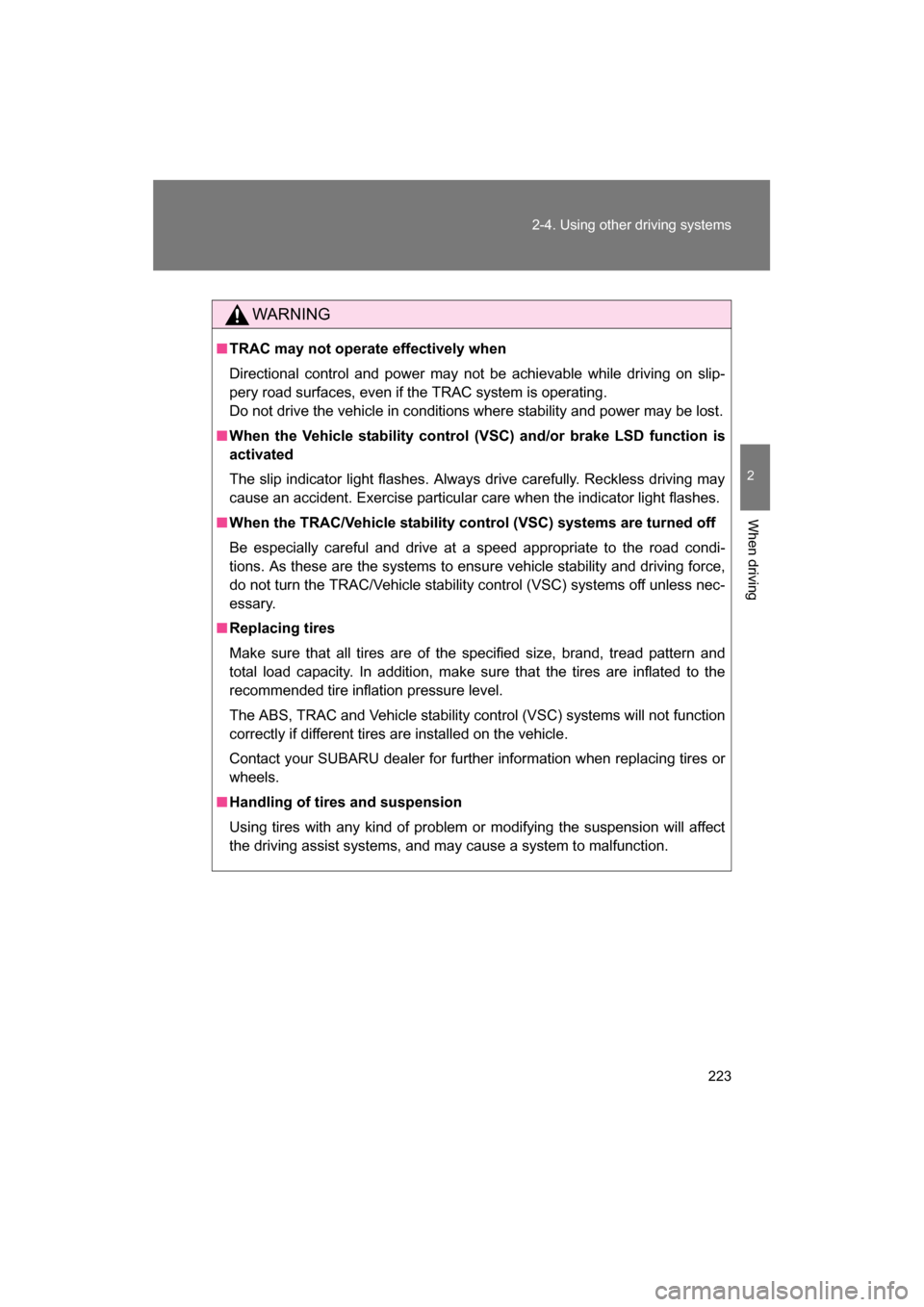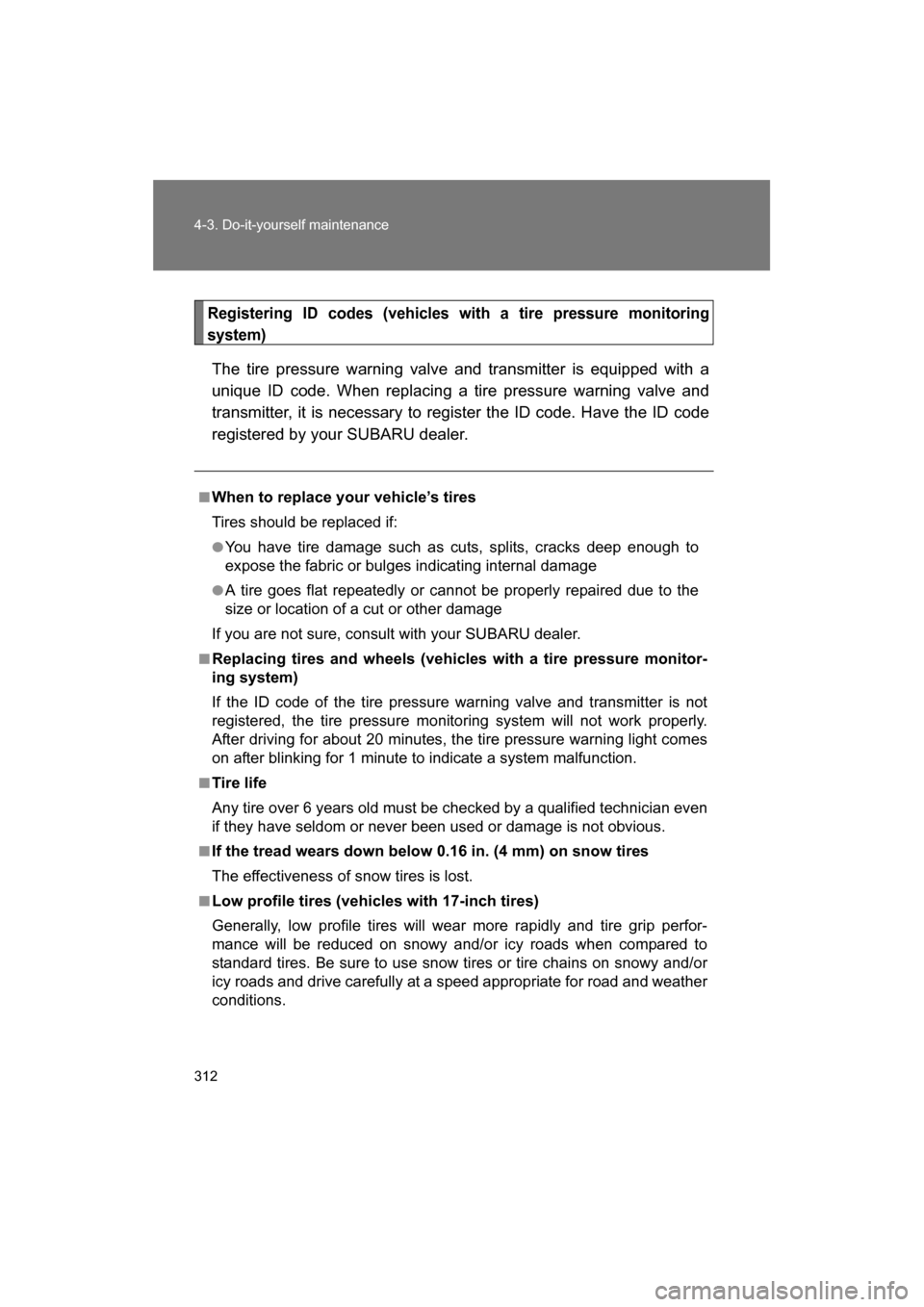Page 1 of 488
TABLE OF CONTENTS
1
1Before drivingAdjusting and operating features such as door locks,
mirrors, and steering column.
2When driving
Driving, stopping and safe-driving information.
3Interior fea-
turesAir conditioning and audio systems, as well as other in-
terior features for a comf
ortable driving experience.
4Maintenance
and careCleaning and protecting your vehicle, performing do-it-
yourself maintenance, and maintenance information.
5When trouble
arisesWhat to do if the vehicle needs to be towed, gets a flat
tire, or is involved in an accident.
6Vehicle
specifications
Detailed vehicle information.
7For owners
Reporting safety defects for US owners, and seatbelt
and SRS airbag instructions for Canadian owners
IndexAlphabetical listing of information contained in this manual.
Page 4 of 488

TABLE OF CONTENTSIndex
4
4-1. Maintenance and care
Cleaning and protecting the vehicle exterior ........... 274
Cleaning and protecting the vehicle interior ............ 278
Cleaning and protecting the Alcantara ®
area.......... 282
4-2. Maintenance Maintenance requirements .................... 284
General maintenance ......... 287
Emission inspection and maintenance (I/M)
programs .......................... 290
4-3. Do-it-yourself maintenance
Do-it-yourself service precautions ...................... 291
Engine hood ....................... 294
Engine compartment .......... 296
Tires ................................... 310
Tire inflation pressure......... 318
Wheels ............................... 322
Air conditioning filter ........... 325
Transmitter/access key battery .............................. 328
Checking and replacing fuses ................................ 332
Light bulbs .......................... 340 5-1. Essential information
Hazard warning flashers ..... 356
If your vehicle needs to be towed ................................ 357
If you think something is wrong ................................ 364
Fuel pump shut off system .............................. 365
5-2. Steps to take in an emergency
If a warning light turns on or a warning buzzer
sounds... .......................... 366
If you have a flat tire ........... 380
If the engine will not start .... 391
If the select lever cannot be shifted from P ................... 394
If you lose your keys ........... 395
If the access key does not operate properly ............... 396
If the battery is discharged ........................ 400
If your vehicle overheats..... 405
If the vehicle becomes stuck ................................. 408
4Maintenance and care5When trouble arises
Page 7 of 488
7
Tires
●Rotation
●Replacement
●Inflation pressure
●Information
P. 310
P. 380
P. 318
P. 428
Rear window defogger P. 252
Trunk lid P. 45
Doors P. 42
Fuel filler lid P. 74
Turn signal lights P. 184
Rear side marker lights P. 202
∗: If equipped
License plate lights P. 202
Tail lights P. 202
Towing eyelet
P. 357
Towing eyelet
P. 357
Page 161 of 488

161
2-1. Driving procedures
2
When driving
CAUTION
■Replacement of brake pad and lining
If you continue to drive despite the scraping noise from the audible brake
pad wear indicator, it will result in the need for costly brake rotor repair or
replacement.
■Breaking-in of new brake pads and linings
Pulling the parking brake lever too forcefully may cause the rear wheels to
lock. To avoid this, be certain to pull the lever up slowly and gently.
■If you get a flat tire while driving
A flat or damaged tire may cause the following situations. Hold the steering
wheel firmly and gradually depress the brake pedal to slow down the vehicle.
●It may be difficult to control your vehicle.
●The vehicle will make abnormal sounds or vibrations.
●The vehicle will lean abnormally.
Information on what to do in case of a flat tire ( →P. 380)
■When encountering flooded roads
Do not drive on a road that has flooded after heavy rain etc. Doing so may
cause the following serious damage to the vehicle:
●Engine stalling
●Short in electrical components
●Engine damage caused by water immersion
In the event that you drive on a flooded road and the vehicle is flooded, be
sure to have your SUBARU dealer check the following:
●Brake function
●Changes in quantity and quality of oil and fluid used for the engine, trans-
mission, differential, etc.
●Lubricant condition for the propeller shaft, bearings and suspension joints
(where possible) and the function of all joints, bearings, etc.
Page 223 of 488

223
2-4. Using other driving systems
2
When driving
WARNING
■TRAC may not operate effectively when
Directional control and power may not be achievable while driving on slip-
pery road surfaces, even if the TRAC system is operating.
Do not drive the vehicle in conditions where stability and power may be lost.
■When the Vehicle stability control (VSC) and/or brake LSD function is
activated
The slip indicator light flashes. Always drive carefully. Reckless driving may
cause an accident. Exercise particular care when the indicator light flashes.
■When the TRAC/Vehicle stability control (VSC) systems are turned off
Be especially careful and drive at a speed appropriate to the road condi-
tions. As these are the systems to ensure vehicle stability and driving force,
do not turn the TRAC/Vehicle stability control (VSC) systems off unless nec-
essary.
■Replacing tires
Make sure that all tires are of the specified size, brand, tread pattern and
total load capacity. In addition, make sure that the tires are inflated to the
recommended tire inflation pressure level.
The ABS, TRAC and Vehicle stability cont rol (VSC) systems will not function
correctly if different tires are installed on the vehicle.
Contact your SUBARU dealer for further information when replacing tires or
wheels.
■Handling of tires and suspension
Using tires with any kind of problem or modifying the suspension will affect
the driving assist systems, and may cause a system to malfunction.
Page 273 of 488
Maintenance and care4
273
4-1. Maintenance and careCleaning and protecting the vehicle exterior......... 274
Cleaning and protecting the vehicle interior.......... 278
Cleaning and protecting the Alcantara ®
area ....... 282
4-2. Maintenance Maintenance requirements .................. 284
General maintenance....... 287
Emission inspection and maintenance (I/M)
programs........................ 290 4-3. Do-it-yourself
maintenance
Do-it-yourself service precautions .................... 291
Engine hood ..................... 294
Engine compartment ........ 296
Tires ................................. 310
Tire inflation pressure ...... 318
Wheels ............................. 322
Air conditioning filter......... 325
Transmitter/access key battery ............................ 328
Checking and replacing fuses .............................. 332
Light bulbs........................ 340
Page 310 of 488
310
4-3. Do-it-yourself maintenance
Tires
Replace or rotate tires in accordance with maintenance sched-
ules and treadwear.
■Checking tiresNew tread
Treadwear indicator
Worn tread
The location of treadwear
indicators is shown by the
“TWI” or “ ” marks, etc.,
molded on the sidewall of
each tire.
Check spare tire condition
and pressure if not rotated.
■Tire rotationRotate the tires in the order
shown.
To equalize tire wear and
extend tire life, SUBARU rec-
ommends that tire rotation is
carried out at the same inter-
val as tire inspection.
■The tire pressure monitoring system (if equipped)
Your SUBARU is equipped with a tire pressure monitoring sys-
tem that uses tire pressure warning valves and transmitters to
detect low tire inflation pressure before serious problems arise. (→ P. 369)
Front
Page 312 of 488

312
4-3. Do-it-yourself maintenance
Registering ID codes (vehicles with a tire pressure monitoring
system)
The tire pressure warning valve and transmitter is equipped with a
unique ID code. When replacing a tire pressure warning valve and
transmitter, it is necessary to register the ID code. Have the ID code
registered by your SUBARU dealer.
■When to replace your vehicle’s tires
Tires should be replaced if:
●You have tire damage such as cuts, splits, cracks deep enough to
expose the fabric or bulges indicating internal damage
●A tire goes flat repeatedly or cannot be properly repaired due to the
size or location of a cut or other damage
If you are not sure, consult with your SUBARU dealer.
■Replacing tires and wheels (vehicles with a tire pressure monitor-
ing system)
If the ID code of the tire pressure warning valve and transmitter is not
registered, the tire pressure monitoring system will not work properly.
After driving for about 20 minutes, the tire pressure warning light comes
on after blinking for 1 minute to indicate a system malfunction.
■Tire life
Any tire over 6 years old must be checked by a qualified technician even
if they have seldom or never been used or damage is not obvious.
■If the tread wears down below 0.16 in. (4 mm) on snow tires
The effectiveness of snow tires is lost.
■Low profile tires (vehicles with 17-inch tires)
Generally, low profile tires will wear more rapidly and tire grip perfor-
mance will be reduced on snowy and/or icy roads when compared to
standard tires. Be sure to use snow tires or tire chains on snowy and/or
icy roads and drive carefully at a speed appropriate for road and weather
conditions.